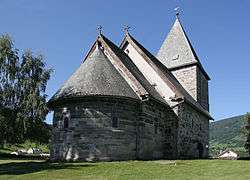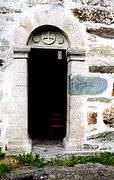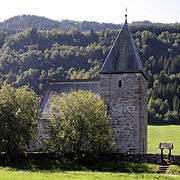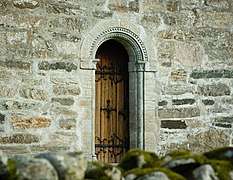Hove Church
Hove Church (Norwegian: Hove kyrkje) is an historic parish church of the Church of Norway in Vik Municipality in Vestland county, Norway. It is located in the village of Vikøyri on the Arnafjord, an arm of the Sognefjord. It was historically the main church for Hove parish in the Diocese of Bjørgvin. The gray, stone church was built in a long church design in a Romanesque style around the year 1170 using designs by the unknown architect. The church seats about 35 people.[1][2]
| Hove Church | |
|---|---|
| Hove kyrkje | |
 View of the Hove Church overlooking Vikøyri on the Arnafjord | |
 Hove Church Location of the church  Hove Church Hove Church (Norway) | |
| 61.0716°N 6.5840°E | |
| Location | Vik Municipality, Vestland |
| Country | Norway |
| Denomination | Church of Norway |
| Previous denomination | Catholic Church |
| Churchmanship | Evangelical Lutheran |
| History | |
| Status | Historic Parish church |
| Founded | c. 1170 |
| Architecture | |
| Functional status | Preserved |
| Architect(s) | Unknown |
| Architectural type | Long church |
| Style | Romanesque |
| Completed | c. 1170 |
| Specifications | |
| Capacity | 35 |
| Materials | Stone |
| Administration | |
| Parish | Vik |
| Deanery | Sogn prosti |
| Diocese | Bjørgvin |
The old parish of Hove (together with the neighboring parish of Hopperstad) was abolished in 1875, and replaced by the new, united Vik parish.
History
The earliest existing historical records of the church date back to the year 1340, but the church was not new that year. It was likely built around the year 1170. Historians believe it was built for a wealthy man who belonged to the very upper echelon within the Norwegian aristocracy. They say he had built this as a private chapel with seating for only about 35 people.[3]
Architect Peter Andreas Blix (1831–1901) bought the church in 1880 and restored the church between 1883-1888. Blix's goal was to finish the stone church to its original conditions. Soapstone for repairing the walls were brought from the old soapstone quarry in the municipality. Just as when he renovated the nearby Hopperstad Stave Church, Blix removed all the fixtures that were not from the Middle Ages. On the exterior Blix built up a large stone tower on the old base of the tower (it had been a wooden tower from 1600 until the 1880s). It is uncertain whether the church had a wood or a stone tower originally. Blix died in 1901 and he is buried under the floor of the church.[3] He owned the church until his death, and bequeathed it to his brother who then gave it to the state.[4] [5]
The church is still owned by the state, and it is administered by the Society for the Preservation of Ancient Norwegian Monuments. Although it is no longer regularly used by the parish for worship services, it is used for special occasions such as weddings or funerals. Since 2017, the annual Nynorsk Church Music Festival ('Nynorsk kyrkjemusikkfestival') has been hosted at the church, with daily Choral Evensong in the English/Anglican tradition, sung by a small chamber choir from England, under the direction of James Reed, a former Kantor in the municipality. [6]
Gallery
See also
References
- "Hove kyrkje". Kirkesøk: Kirkebyggdatabasen. Retrieved 2019-12-07.
- "Oversikt over Nåværende Kirker" (in Norwegian). KirkeKonsulenten.no. Retrieved 2019-12-07.
- Sæbø, Arne Inge. "Hove steinkyrkje" (in Norwegian). Fylkesarkivet. Retrieved 2019-12-07.
- "Hove kyrkjestad m. områdefreding" (in Norwegian). Norwegian Directorate for Cultural Heritage. Retrieved 2019-12-07.
- "Peter Andreas Blix". Store norske leksikon. Retrieved October 1, 2016.
- Nina Aldin Thune. "Hove kirke". Store norske leksikon. Retrieved October 1, 2016.
.jpg)








